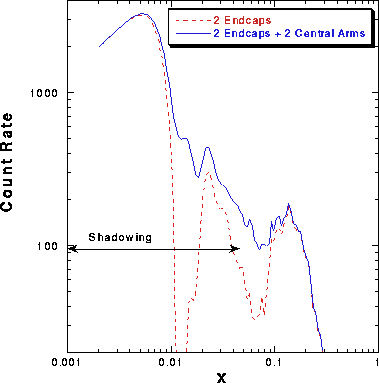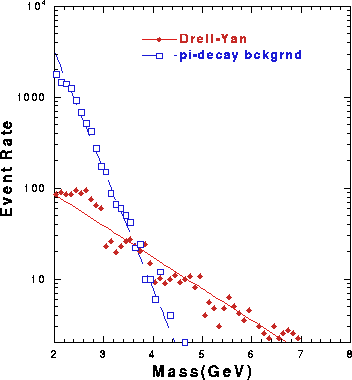



Next: Detection of High-
Up: The PHENIX Muon
Previous: The Second Muon
Detection of muons in the dual arms of the central magnet produces a significant increase in
acceptance for high- muon pairs, as is shown by Fig. 3. Most of this increase arises from the
detection of one muon in a central arm and the other in an end cap. This combination also produces
acceptance in the regions,
muon pairs, as is shown by Fig. 3. Most of this increase arises from the
detection of one muon in a central arm and the other in an end cap. This combination also produces
acceptance in the regions,
 and
and
 , which are otherwise inaccessible as is evident in Fig. 13.
This kinematic
region is extremely important for the study of shadowing in pA and AA collisions.
Shadowing is observed in nuclear quark distributions in DIS experiments for
, which are otherwise inaccessible as is evident in Fig. 13.
This kinematic
region is extremely important for the study of shadowing in pA and AA collisions.
Shadowing is observed in nuclear quark distributions in DIS experiments for  .
.

Figure 13: Acceptance of the upgraded PHENIX muon spectrometer for Drell-Yan
pairs,  , versus x with and without
muon detection in the arms of the central magnet. The arrow shows
the expected region of nuclear shadowing in pA and
AA collisions.
, versus x with and without
muon detection in the arms of the central magnet. The arrow shows
the expected region of nuclear shadowing in pA and
AA collisions.
The large radius (5 m) to the beginning of the
electromagnetic calorimeter is hardly ideal for suppressing pion and kaon decays. However
we envision use of the central arms primarily for the detection of high-mass dimuons. Here
the exceedingly steep falloff of the hadron  spectrum combined with the small probability
of having two such events nearly back to back leaves the high-mass range of the spectrum
free from backgrounds. Figure 14 compares the rate of DY events entering the central arms
with backgrounds from pion decay in pp collisions at
spectrum combined with the small probability
of having two such events nearly back to back leaves the high-mass range of the spectrum
free from backgrounds. Figure 14 compares the rate of DY events entering the central arms
with backgrounds from pion decay in pp collisions at  . Even though the
acceptance for true DY events in the central arms only is quite small, the
background from pion decays is negligible for
. Even though the
acceptance for true DY events in the central arms only is quite small, the
background from pion decays is negligible for  . The background rate from kaon decay
relative to pion decay is estimated to be lower by a factor of
. The background rate from kaon decay
relative to pion decay is estimated to be lower by a factor of  4.
4.

Figure 14: Simulation of Drell-Yan events in the central magnet arms compared
to background from pion decays at  . The
simulations were performed with PISA[41], using
pion production cross sections from Alper, et al.
[42]. Perfect muon identification was assumed.
. The
simulations were performed with PISA[41], using
pion production cross sections from Alper, et al.
[42]. Perfect muon identification was assumed.




Next: Detection of High-
Up: The PHENIX Muon
Previous: The Second Muon
Converted to HTML from LaTeX by W. Wayne Kinnison
Sun Nov 5 18:47:30 MST 1995
 muon pairs, as is shown by Fig. 3. Most of this increase arises from the
detection of one muon in a central arm and the other in an end cap. This combination also produces
acceptance in the regions,
muon pairs, as is shown by Fig. 3. Most of this increase arises from the
detection of one muon in a central arm and the other in an end cap. This combination also produces
acceptance in the regions,
 and
and
 , which are otherwise inaccessible as is evident in Fig. 13.
This kinematic
region is extremely important for the study of shadowing in pA and AA collisions.
Shadowing is observed in nuclear quark distributions in DIS experiments for
, which are otherwise inaccessible as is evident in Fig. 13.
This kinematic
region is extremely important for the study of shadowing in pA and AA collisions.
Shadowing is observed in nuclear quark distributions in DIS experiments for  .
.

 , versus x with and without
muon detection in the arms of the central magnet. The arrow shows
the expected region of nuclear shadowing in pA and
AA collisions.
, versus x with and without
muon detection in the arms of the central magnet. The arrow shows
the expected region of nuclear shadowing in pA and
AA collisions. spectrum combined with the small probability
of having two such events nearly back to back leaves the high-mass range of the spectrum
free from backgrounds. Figure
spectrum combined with the small probability
of having two such events nearly back to back leaves the high-mass range of the spectrum
free from backgrounds. Figure  . Even though the
acceptance for true DY events in the central arms only is quite small, the
background from pion decays is negligible for
. Even though the
acceptance for true DY events in the central arms only is quite small, the
background from pion decays is negligible for  . The background rate from kaon decay
relative to pion decay is estimated to be lower by a factor of
. The background rate from kaon decay
relative to pion decay is estimated to be lower by a factor of  4.
4.

 . The
simulations were performed with PISA[
. The
simulations were performed with PISA[